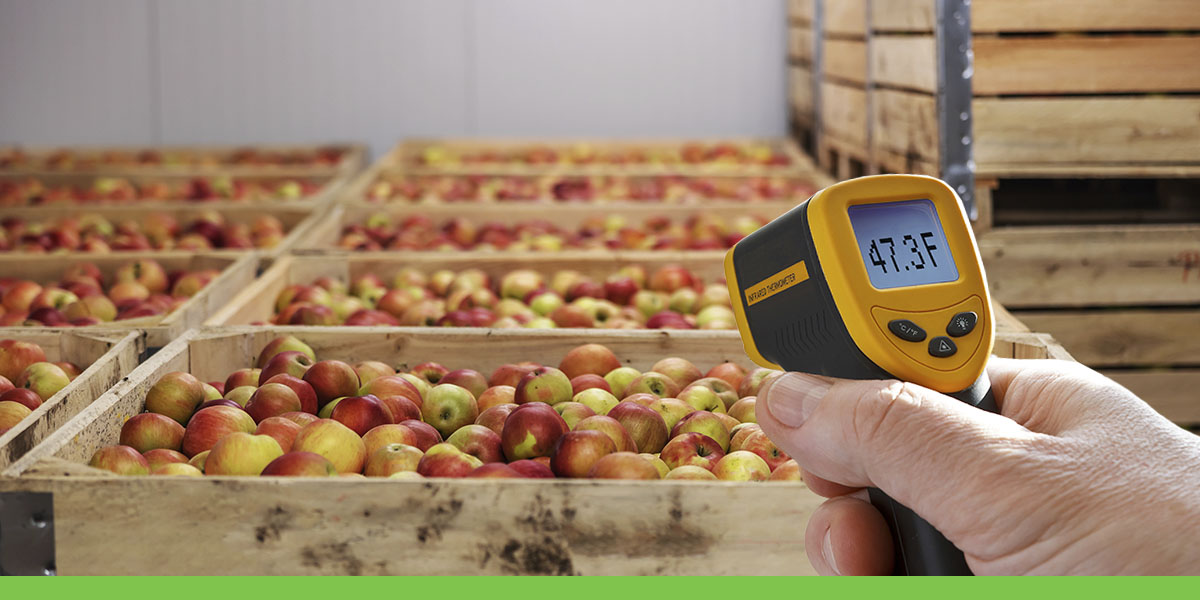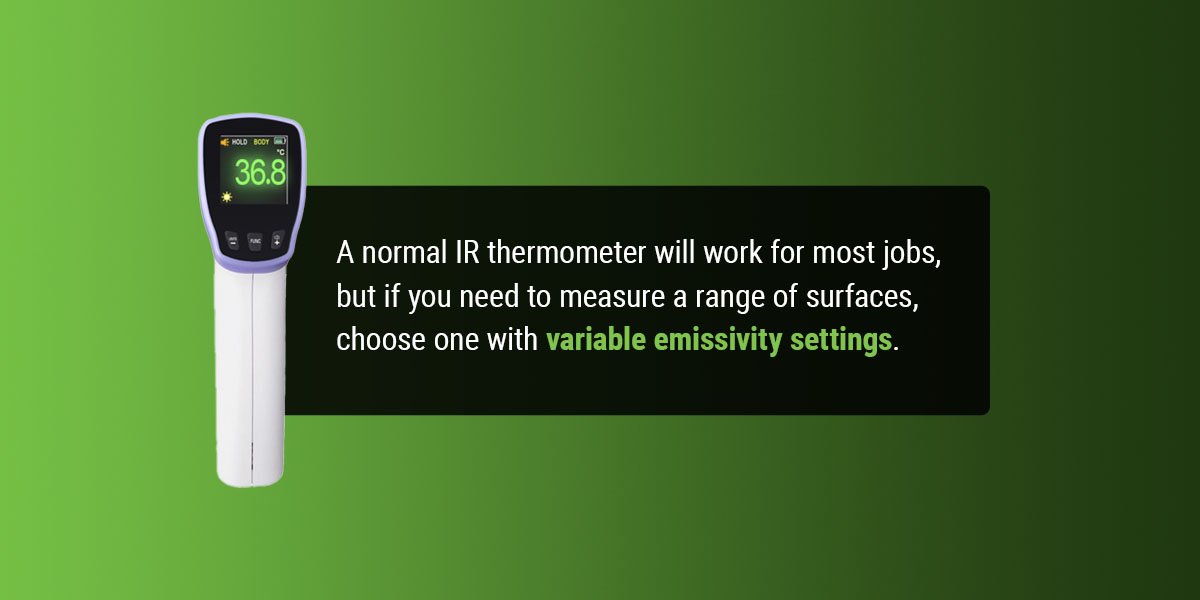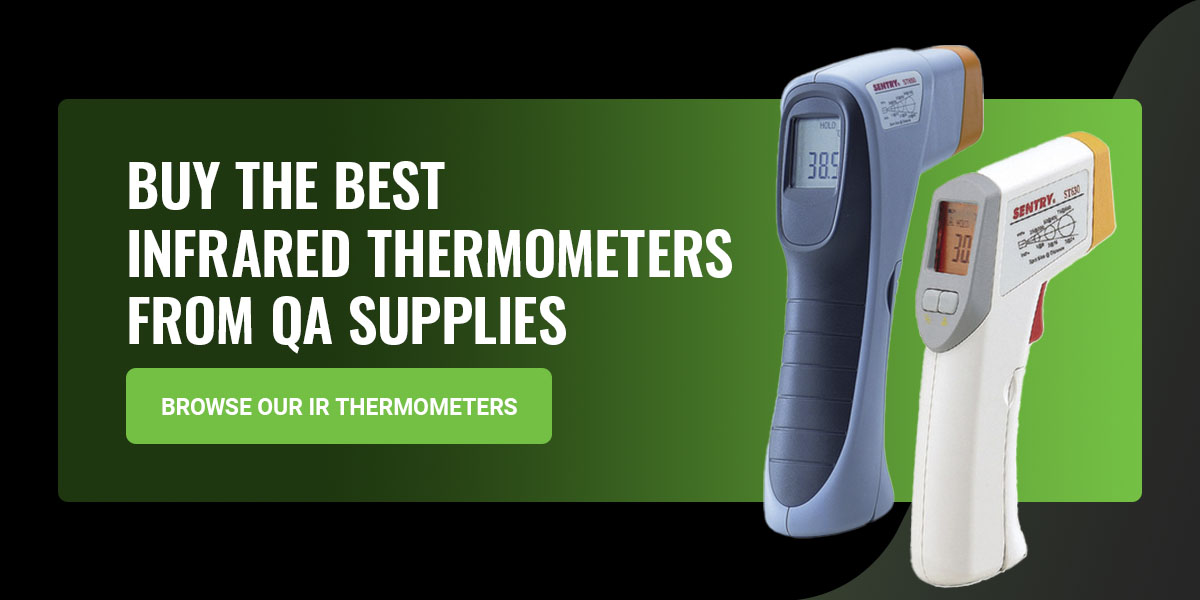Choosing the Best Infrared Thermometer for Your Application
Mar 26th 2024

Having the right kind of infrared thermometer is vital for accuracy and usefulness, and there are multiple types and specifications to consider. Use this guide to help you understand the differences and choose the best one for your application.
The Science Behind Infrared Thermometers
Infrared radiation (IR) thermometers are vital tools in multiple industries as they can quickly read surface temperatures from a distance. IR thermometers have a special lens that focuses infrared radiation — a type of electromagnetic radiation invisible to the eye — onto a sensor and converts it into an electrical signal, which the thermometer outputs as a temperature reading.
Every object emits a certain level of infrared radiation, which you'll feel as warmth. The most obvious example of infrared radiation is fire, which you can feel with your hands and even see with your eyes. The intensity of the radiation directly correlates to how hot it is. Hot objects emit stronger levels of infrared radiation than colder ones, leading to higher temperature readings.
Key Considerations for Selecting an Infrared Thermometer
1. Temperature Range
IR thermometers have specific temperature ranges they can record, which are listed in the product specifications. Some IR thermometers are good for reading small temperature ranges — like for the human body — while others can record extremely high temperatures in industrial applications.
It's important to choose a thermometer with a range that matches the temperatures you are recording. Even with IR thermometers that can read a wide range of temperatures, you still need to calibrate them to a smaller portion of that range to produce an accurate reading.
2. Distance-to-Spot Ratio
IR thermometers measure the temperature of a surface by recording the average radiation across a specific area size, called a spot. This is also referred to as its field of view, and is essentially the diameter of the circular area the device can measure. As you move the thermometer further away from the object's surface, the spot size or field of view increases. Visually, the circular area it can measure will become larger.
IR thermometer manufacturers provide a distance-to-spot (D:S) ratio to help users calculate the spot size they can measure from a certain distance. The first number refers to the distance, and the second is the spot diameter. For example, a thermometer with a D:S ratio of 6:1 can measure a 1-inch diameter spot from 6 inches away and a 2-inch diameter spot from 12 inches away.
IR thermometers can only accurately provide a reading if the object's surface covers the entire spot or field of view. So, if you need to measure a small area from very far away, you'll need a high D:S ratio like 60:1. This will let you measure a 1-inch spot from a distance of 60 inches.
3. Emissivity

Another important IR thermometer specification is emissivity, which is the measure of an object's effectiveness in emitting thermal radiation, like infrared radiation. Surfaces can have emissivity levels between 0 to 1, with 1 being the highest level of infrared radiation. Materials closer to the 0 end of the spectrum are usually reflective, like metal or a mirror.
Most IR thermometers are pre-set to measure emissivity of 0.95, as this is a common measurement for most non-reflective, organic or oxidized surfaces. Examples of items with around 0.95 emissivity include concrete, food, paint, plastic, rubber, soil, water and human skin. This becomes a problem when you need to measure surfaces with lower emissivity, such as brass, chromium, copper, steel and other metals.
A normal IR thermometer will work for most jobs, but if you need to measure a range of surfaces, choose one with variable emissivity settings. You can then adjust the thermometer's emissivity level to match the surface you're measuring.
4. Response Time
The speed at which a thermometer takes readings is called its read speed or response time. While some applications — like testing for a fever at home — don't particularly need speedy readings, others rely on fast readings to assist with decision-making and quality control. This includes cooking a steak or working with metal, where temperatures can change quickly.
Faster read speeds are almost always better, but you should consider which speed suits your application when choosing an IR thermometer. Thermometers with less than a second response time will provide the most accurate and useful results.
5. Lens Type
Different types of thermometers have varying lens types, which affect their durability, cost, accuracy and temperature range. The three main lens types in IR thermometers are:
- No-lens: No-lens IR thermometers are the cheapest kind and are quite durable, but you can only use them for colder temperatures and close distances.
- Fresnel lens: These thermometers have narrow temperature ranges, making them perfect for the food industry, but they need time to acclimate to temperature changes.
- Mica lens: Mica lens IR thermometers are the most expensive as they have complex lenses that can measure extreme temperatures and take readings from far away. The one drawback to these is they can break easily.
Infrared Thermometer Uses
- Food safety and HACCP: Food preparation staff and manufacturers use IR thermometers to check the temperature of food to determine if it's cooked through, safe to eat and stored at the right temperature to limit bacteria growth or spoiling.
- Agriculture: Workers in horticulture and animal husbandry use IR thermometers to monitor soil, plant and fish tank temperatures and find soiled bedding in enclosures.
- Circuitry and wiring: IR thermometers help technicians find faulty terminations, overloaded circuit breakers and near-capacity fuses.
- Manufacturing: Factory staff use IR thermometers for various applications, such as curing resin, checking products on production lines, drying rubber and plastic, smelting metals, firing ceramics, painting and many more.
- Construction: Construction workers use IR thermometers to check if the desired temperature has been reached while heating surfaces or if materials like concrete have set.
- Machinery: Moving parts in machines and motors may heat up if something is wrong, so workers use thermometers to monitor the temperature to prevent costly repairs.
- Health care: Health care workers use IR thermometers to check patient temperatures for signs of fever or illness.
- HVAC: IR thermometers help find leaks in ducts and furnaces, and detect insulation breakdown or heat loss in walls and ceilings.
Buy the Best Infrared Thermometers From QA Supplies
QA supplies stocks a range of competitively priced IR thermometers for food service, health care and industrial professionals. We only stock the best, and most of the thermometers we sell have ergonomic handles and intuitive control panels for easy use. We also offer fast and convenient calibration services to keep your thermometer in top shape.
Browse our infrared thermometers today or call us at


